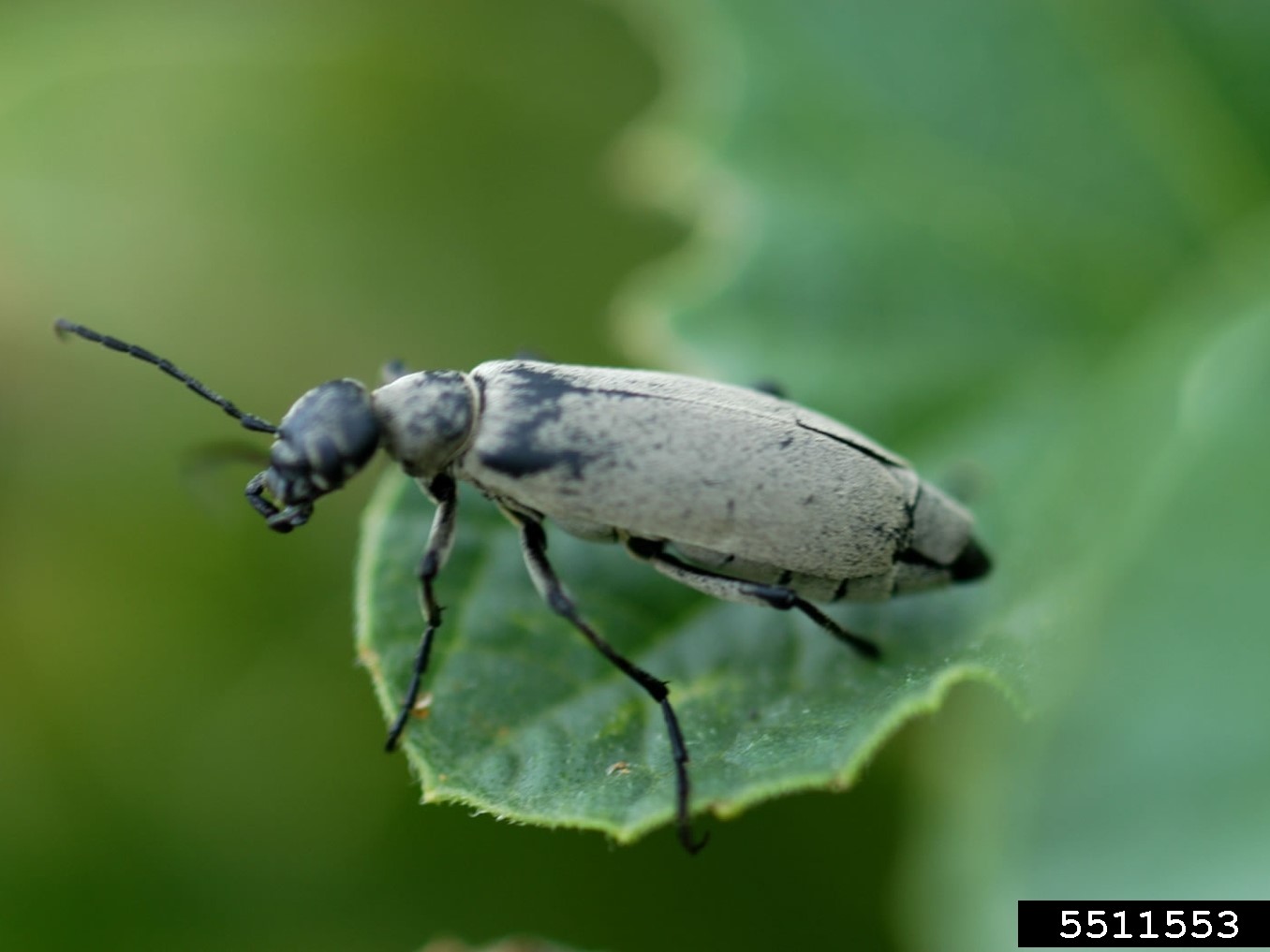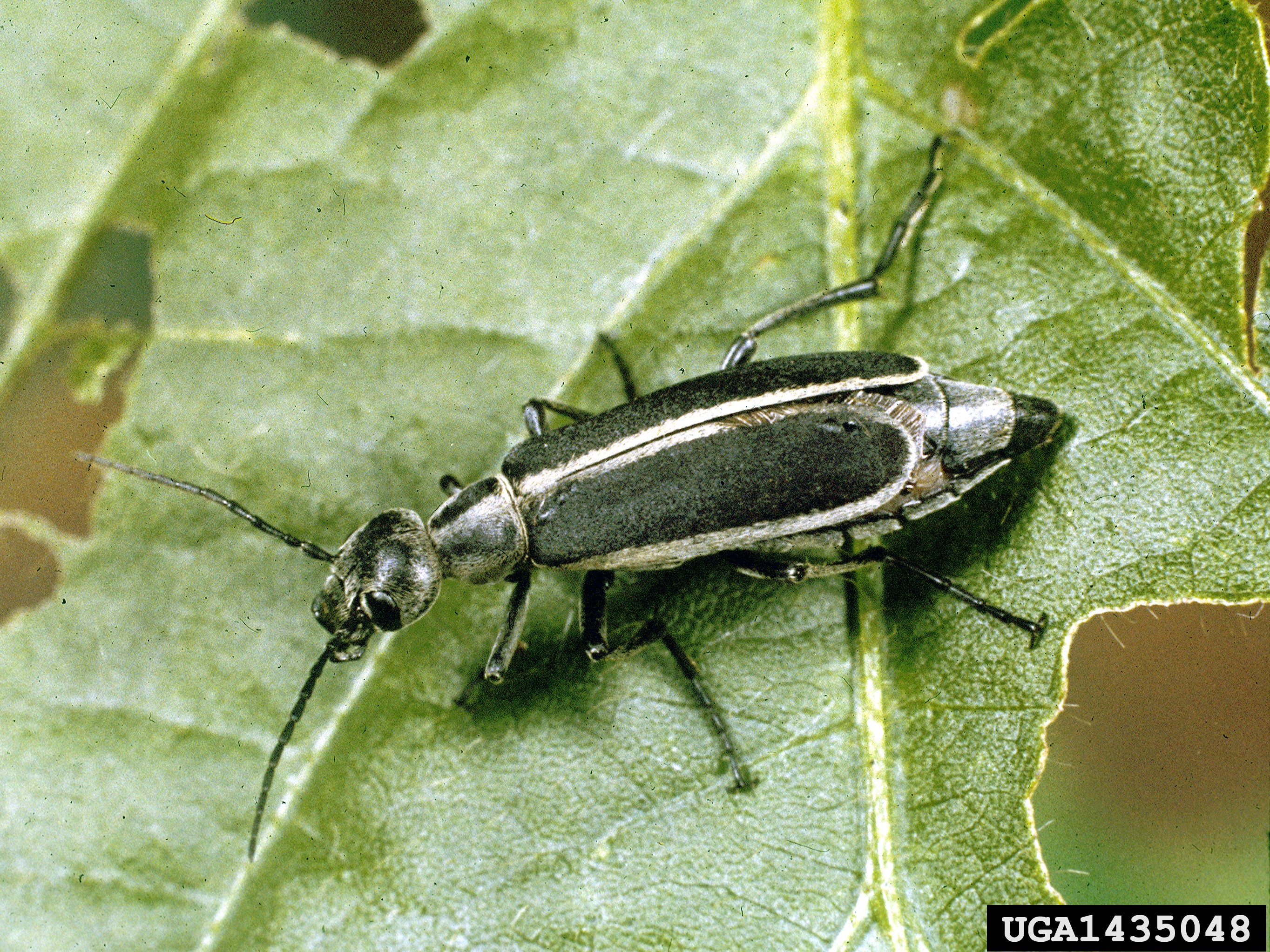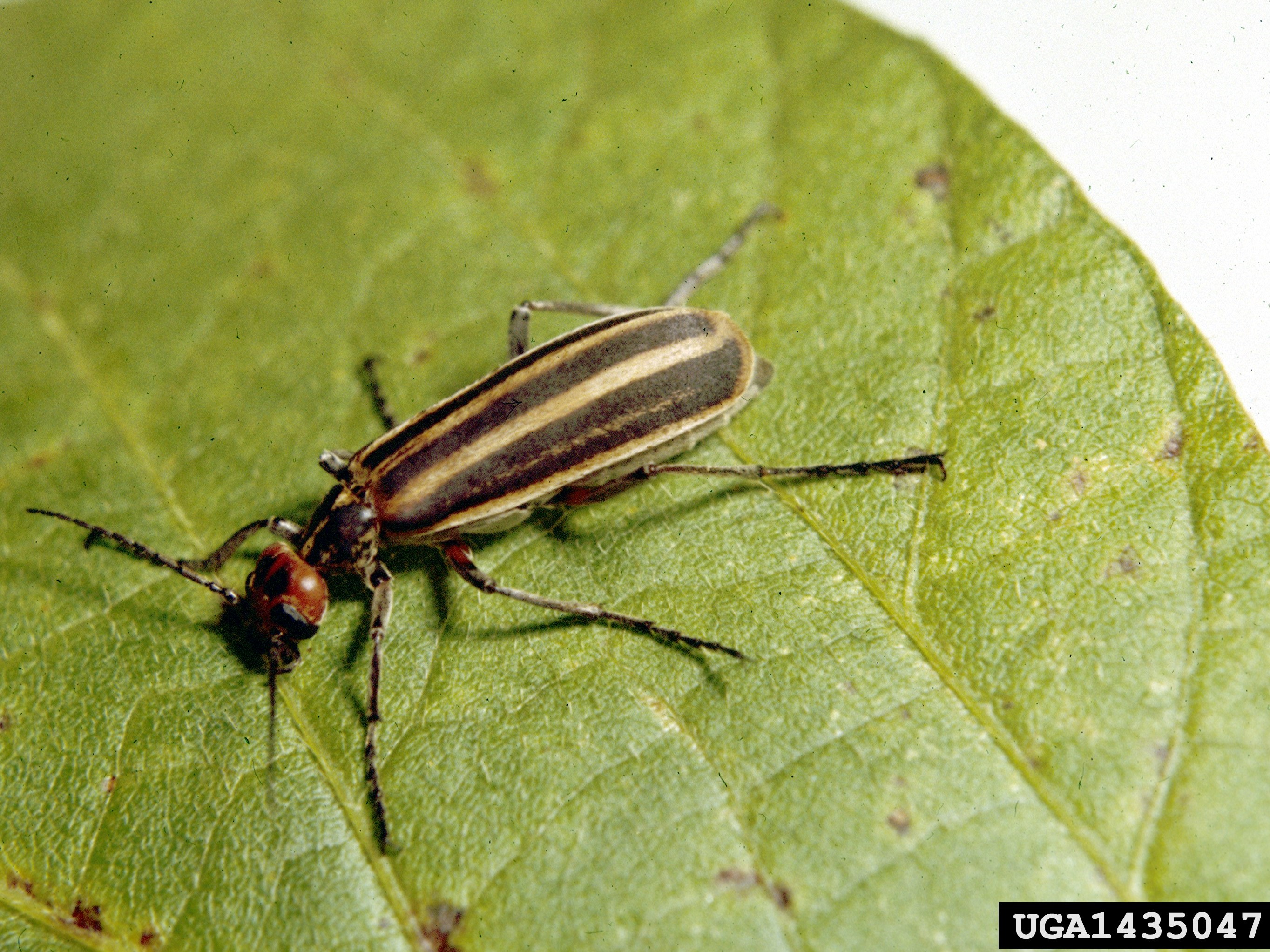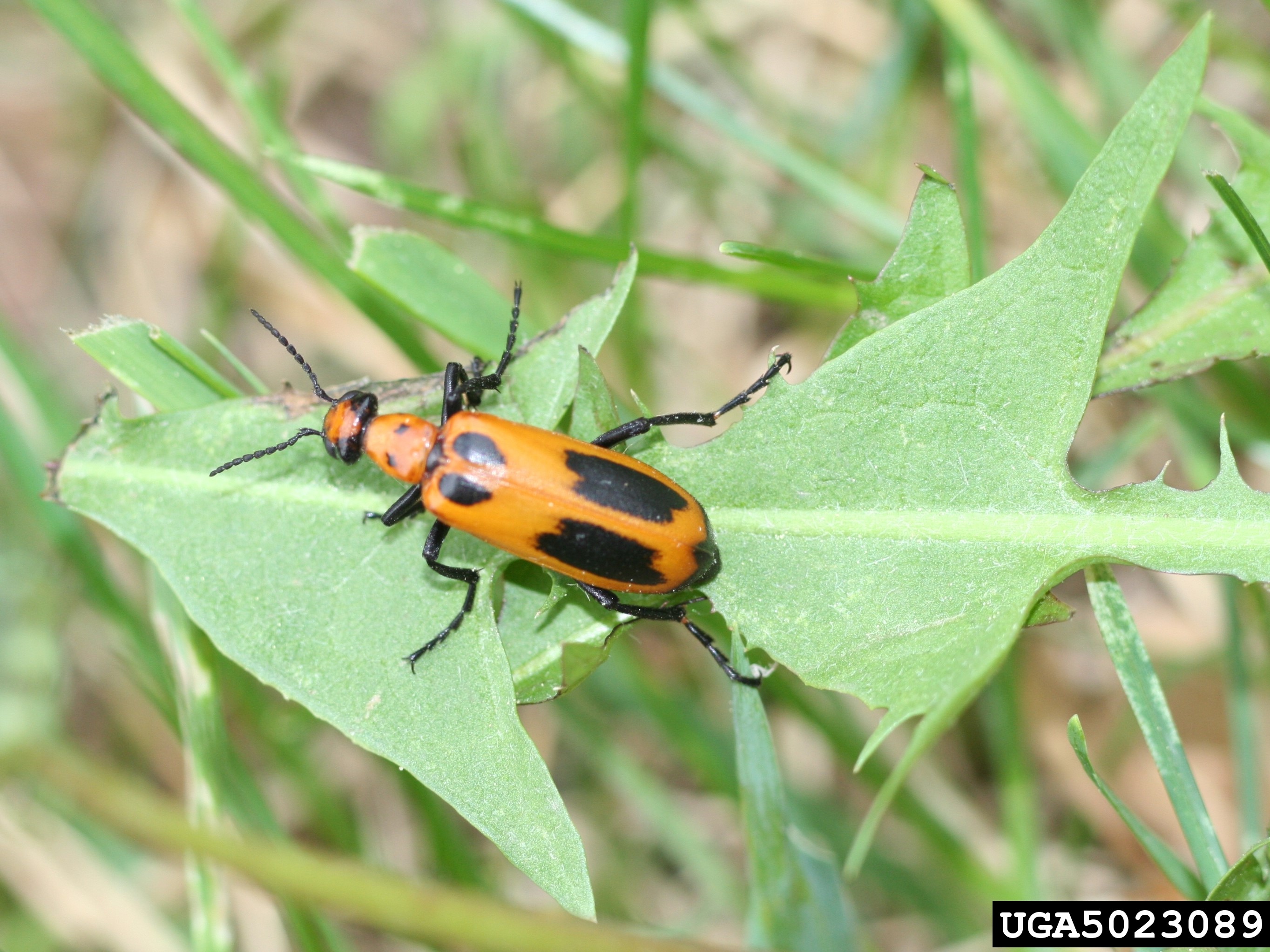 Blister Beetles - July 28, 2021 Jeff Schalau, Agent, Agriculture & Natural Resources University of Arizona Cooperative Extension, Yavapai County Blister beetles often appear in northern Arizona this time of year. These insects are interesting for two reasons. First, gardeners become alarmed due to their voracious consumption of ornamental and crop plants. Second, horse owners are sometimes fearful of blister beetles because they have been known to cause poisoning of horses. Nonetheless, horse poisoning by blister beetles is a rare occurrence unless dead blister beetles are present in their hay. Horse poisoning is rare to nonexistent when live blister beetles are present in the horse’s environment. Blister beetles (family Meloidae) are found throughout Arizona. These beetles contain a defensive chemical (cantharidin) that may be harmful to humans and other animals. Blister beetles are often confused with other similar looking beetles that do not produce cantharidin. Blister beetles are found in many different sizes and colors. However, they all share the characteristic feature of a broad head that is wider than the thorax (“neck”). This, combined with broader elytra (wing covers), creates a distinct “neck-like” appearance. Blister beetles are sometimes confused with checkered beetles, soldier beetles, darkling beetles, ground beetles and other beetles. Blister beetles have a complex life cycle that makes them highly effective biological control agents of several insect species, including grasshoppers. After feeding and mating in late summer, adult blister beetles lay eggs in areas of rangeland that may serve as breeding grounds for grasshoppers. After hatching from eggs, the highly mobile blister beetle larvae seek out and feed on grasshopper eggs. Through autumn and winter, maturing larvae become less mobile and more grub-like in appearance, and they develop a bigger appetite for grasshopper eggs. Eventually, the larvae complete their development and pupate in the spring. Adult blister beetles have chewing mouthparts and feed on a wide range of flowering weeds, including goldenrod (Solidago spp.), ironweed (Vernonia spp.), ragweed (Ambrosia spp.), and pigweed (Amaranthus spp.). Their feeding can be injurious to commercial vegetable crops such as potato, tomato, corn, carrot, melon, pea, bean, cabbage, and beet. They have also been reported to cause damage to alfalfa, mustard, clover, and other herbaceous. Some species of blister beetles tend to congregate and feed in swarms on these crops, which can lead to concern for producers. Adult beetles can defoliate host plants, leaving nothing but leaf petioles and stems. Some experts claim blister beetle feeding damage to vegetable crops and ornamental plants is minor and does not necessitate blister beetle management actions. In addition, the complex relationship between grasshoppers and blister beetles paints a picture of blister beetles having a benefit in reducing future grasshopper activity. Regardless, when vegetable and flower crops are being rapidly consumed by blister beetles, often in large numbers, it can be alarming, and most gardeners want to act. Since there are no “official” recommended management actions for home gardeners, I will suggest a couple of non-chemical management actions for vegetables and flowers. Wear a pair of disposable gloves, hand pick the blister beetles, and place them in a container with a solution of soapy water. Soapy water will kill these beetles. The disposable gloves are to prevent potential skin irritation related to cantharidin exposure. Similarly, a shop-vac could be used to remove the beetles. If there are larger crop plants at risk, they could be covered with floating row cover (also called “Remay”) to provide a physical barrier to blister beetle feeding. I’m not sure if direct insecticidal soap applications would be enough to kill blister beetles in their tracks. Applications of other contact insecticides could be used on non-edible crops. Feeding on woody plants should be tolerated as most of these plants can usually withstand infrequent defoliation. Horse owners should understand the greatest blister beetle risk to their horses is if the beetles have been killed during hay harvest and are present in baled hay. Horses do not want to consume live blister beetles any more than you or I do. If blister beetles are in a water trough, scoop them out with a net. They can be placed in a solution of soapy water if killing them is desired. Otherwise, live blister beetles pose minimal risks to horses. See below for more information and images of blister beetles. You can follow the Backyard Gardener on Twitter – use the link on the BYG website. If you have other gardening questions, email the Master Gardener Help Desk in Prescott (prescottmg@gmail.com) or Camp Verde (verdevalleymg@gmail.com) and be sure to include your name, location, and phone number. Find past Backyard Gardener columns or provide feedback at the Backyard Gardener web site: https://cals.arizona.edu/yavapai/anr/hort/byg/. Images  Ashgray blister beetle (Epicauta fabricii, Ward Upham, Kansas State University, Bugwood.org).
Ashgray blister beetle (Epicauta fabricii, Ward Upham, Kansas State University, Bugwood.org). Margined blister beetle (Epicauta funebris, Clemson University - USDA Cooperative Extension Slide Series, Bugwood.org).
Margined blister beetle (Epicauta funebris, Clemson University - USDA Cooperative Extension Slide Series, Bugwood.org). Striped blister beetle (Epicauta vittata, Clemson University - USDA Cooperative Extension Slide Series , Bugwood.org).
Striped blister beetle (Epicauta vittata, Clemson University - USDA Cooperative Extension Slide Series , Bugwood.org). (Pyrota insulata, Whitney Cranshaw, Colorado State University, Bugwood.org).
(Pyrota insulata, Whitney Cranshaw, Colorado State University, Bugwood.org).Additional Resources Blister Beetle Identification, University of Arizona Pest Management Center cals.arizona.edu/crops/cotton/files/BBid.pdf Blister Beetles – A Challenge for Arizona’s Growers, University of Arizona Pest Management Center acis.cals.arizona.edu/docs/default-source/pest-identification-documents/presentations/blisterbeetleposter.pdf Blister Beetle, Texas A & M Extension Entomology extensionentomology.tamu.edu/insects/blister-beetle/ Blister Beetles: Pest or Beneficial Predator, Washington State University Extension s3.wp.wsu.edu/uploads/sites/2071/2013/07/Blister-Beetles_FS113E.pdf Blister Beetles in Forage Crops, Colorado State University Extension extension.colostate.edu/topic-areas/insects/blister-beetles-in-forage-crops-5-524/ |